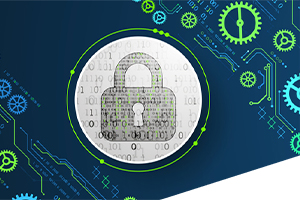Cyber Resilience-Building a Strong Defense Against Evolving Threats
Introduction: Cyber threats continue to evolve and proliferate, and businesses must prioritize their cybersecurity strategies to protect their...
3 min read
![]() Zones
:
Aug 18, 2023 8:58:00 AM
Zones
:
Aug 18, 2023 8:58:00 AM

Safeguarding sensitive data and adhering to regulatory requirements are paramount for every business. As cyber threats evolve, companies must adopt a proactive approach to fortify their defenses. Organizations face an ever-evolving threat landscape, with cybercriminals constantly seeking new ways to breach data, disrupt operations, and compromise sensitive information. Security Controls and Governance, Risk, and Compliance (GRC) come to the rescue, providing a comprehensive framework to manage security risks and regulatory adherence effectively.
This blog post delves into security controls and GRC, highlighting their significance in protecting businesses from potential risks and the numerous benefits they bring to the table.
Security Controls serve as the defense against external and internal threats. They encompass a range of policies, practices, and technologies designed to protect information assets, systems, and infrastructure from unauthorized access, disclosure, or destruction. The foundation of Security Controls lies in the ability to detect, control, and respond to security incidents in real time.
Organizations can benefit from heightened readiness against cyber-attacks by implementing robust Security Controls. These controls empower IT teams to identify potential vulnerabilities and swiftly take action to mitigate risks. Regular audits and assessments strengthen security posture, instilling confidence in customers and stakeholders.
Moreover, security controls fortify regulatory compliance efforts, a critical aspect of any successful enterprise. Adherence to industry standards and regulations helps businesses avoid fines and legal repercussions. Beyond compliance, organizations gain a competitive edge by showcasing their dedication to protecting customer data and enhancing their brand reputation.
Effective governance forms the backbone of a successful business, ensuring that policies and procedures are well-defined, implemented, and maintained. It establishes a clear line of responsibility and accountability, guiding decision-making processes throughout the organization. When combined with Security Controls, governance creates a unified security and compliance management approach.
A well-structured governance framework fosters transparency, aligning security and compliance objectives with overall business goals. This proactive approach encourages the adoption of best practices and continuous improvement. Additionally, strong governance paves the way for a culture of security awareness, where employees become active participants in safeguarding the organization. Organizations can address and resolve potential threats by outlining escalation procedures and communication protocols.
Risk is an inherent aspect of any business operation, and GRC strategies help identify, assess, and mitigate these risks effectively. GRC unifies risk management efforts, providing a holistic view of potential threats and vulnerabilities. By taking a proactive stance on risk, businesses can minimize the impact of adverse events.
One of the significant advantages of implementing a robust GRC framework is the reduction in compliance costs. Organizations can optimize resource allocation and allocate more time and effort toward growth and innovation by streamlining processes and automating compliance procedures. Moreover, a robust risk management program enhances decision-making, enabling agile responses to emerging threats and opportunities.
Compliance with industry regulations and legal requirements is essential for maintaining an organization's credibility and reputation. GRC solutions offer a centralized platform to monitor and enforce compliance across various frameworks, simplifying the complex landscape of regulatory requirements.
By integrating Security Controls and GRC practices, organizations can effortlessly identify gaps in compliance and address them promptly. This comprehensive approach minimizes the risk of non-compliance penalties and legal repercussions. Furthermore, adherence to industry standards fosters trust among clients, partners, and regulators, positioning your business as a reliable and compliant market player.
By implementing automated compliance monitoring, conducting regular audits, and enforcing policies and procedures, businesses can avoid penalties, maintain customer trust, and demonstrate a commitment to data privacy and security.
Businesses create a synergistic security ecosystem by integrating governance, risk management, and compliance. These three components complement one another, forming a robust line of defense against cyber threats. This integration enhances data protection, strengthens security controls, and ensures adherence to industry standards.
Security controls and GRC practices protect businesses from financial losses from data breaches, legal penalties, and reputational damage.
A strong security stance fosters customer trust, enhances loyalty, increased customer satisfaction, and improves brand reputation.
Compliance with industry regulations helps businesses avoid penalties and maintain a competitive edge in their respective markets.
Security controls and GRC practices ensure uninterrupted operations, minimizing disruptions and downtime caused by security incidents.
By actively monitoring and assessing risks, organizations can anticipate potential threats and implement necessary measures to mitigate them effectively.
Organizations must prioritize security controls, governance, risk, and compliance in an increasingly sophisticated cyber threats era. By embracing proactive security strategies, organizations can fortify their defenses, enhance customer trust, and maintain a competitive advantage in today's digital landscape.
In an era where cyber threats continue to escalate, organizations must adopt a proactive and comprehensive approach to security controls and GRC. Organizations can effectively mitigate risks, protect their assets, maintain a competitive advantage, and safeguard their reputation by strengthening defenses, ensuring regulatory compliance, streamlining operations, enhancing risk management, fostering trust, and embracing continuous improvement. Investing in robust security controls and a GRC framework is not just a prudent business decision—it is imperative for long-term success in today's digital landscape.

Introduction: Cyber threats continue to evolve and proliferate, and businesses must prioritize their cybersecurity strategies to protect their...

In today's digital age, IT security is essential for any business. As our reliance on technology and the internet rises, the risk of cyber-attacks...
-%26-Cybersecurity-Blog-Image.png)
Data security has never been as important as before, especially in the modern world, which instantly turns to the online sphere to solve most...